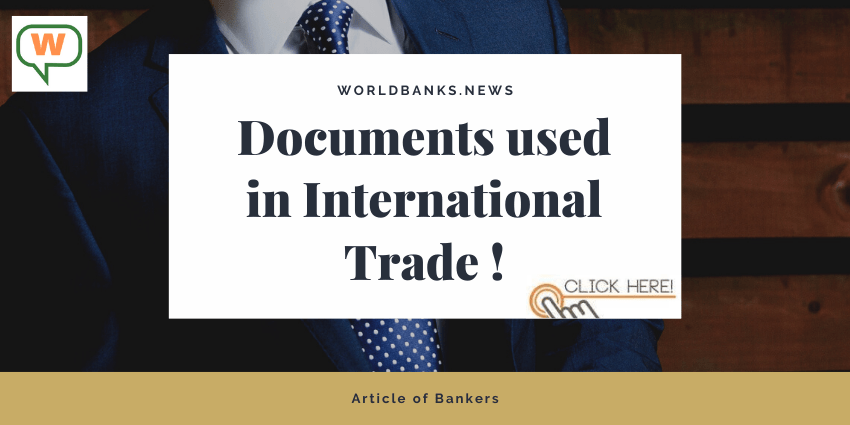DOCUMENTS USED IN INTERNATIONAL TRADE
Write down different categories of documents used in international Trade?
Commercial Invoice: Commercial Invoice is the sellers bill for merchandise. It is an evidence of sale drawn up by the seller on his letter head pad & contains all relevant information such as full name & address of the consignee, quantity, quality, unit price & total price, L/C number, import license number, packaging particulars, terms of trade etc. There is no particular form of commercial invoice & each exporter designs his own commercial invoice form. Usually a commercial invoice is required to be duly receipted & signed by the seller & is submitted in a set of at least three copies.
Certified Invoice: A commercial invoice become certified invoice when it is certified by the exporter. The Certification states that the goods are of a particular country of origin & specification of the goods is in conformity with the contract or proforma invoice.
Consular Invoice: Consular invoice is a special format of invoice certified by the consular officer of the importer stationed in exporters country. This invoice certifies that the goods shipped and sworn as being correct in all respects. A consular invoice may also contain a declaration about the place of origin of goods.
Legalized/ Visaed invoice: The Legalized or visaed invoice is similar like consular invoice except a difference that for this type of invoice no special format is used. Exporter produce the commercial invoice & Embassy or consulate office certify the invoice by counter sign. Certain countries in Middle East require legalized or visaed invoice.
Customs invoice: Certain countries such as USA, Canada require Customs Invoice. Canada has prescribed specific form of customs invoice for allowing entry of merchandise into Canada at preferential tariff rate. Such invoices are required for inter commonwealth trade for the purpose of obtaining preferential tariff rate.
Other invoices: Countries like USA and Canada require customs invoice in the prescribed form for the purpose of their customs valuation. Special forms of invoice are also used for trade between members of other free trade areas such as the EEC and LAFTA.
Certificate of origin: A certificate of origin declares the place of actual manufacture or growth of the goods. A country may place restriction on import from a particular country or preferential treatment may be accorded in tariff for import from certain countries. Usually such certificates provided by the Chamber of Commerce or Trade Association in the exporting country. * Weight Note or Certificate: This gives the weight of individual items shipped. It is generally issued by a public agency & since the certificate issued by an independent agency, importer is assured that goods of proper weight have been shipped.
* Packing list: This list would contains details of goods contained in individual packages. This helps in identifying the contents of specified packages and thus may facilitate assessment by the customs.
* Quality or inspection certificate: This would be issued by the exporter or independent inspection agency that the goods were examined and found to be as required under the contract of sale.
What are the Official Documents?
Ans. i). Consular Invoice. ii). Legalized or Visaed Invoice. iii). Black List Certificate. iv). Phyto sanitary Certificate.
What is ‘Black list Certificate’ & ‘Phyto Sanitary Certificate’?
Ans. i). Black List Certificate: A country at war with or having strained political relationship with another country may require a black list certificate to ensure that : i). The goods are not of the origin of that country ii). The parties involved in the transaction are not blacklisted or iii). The transport vessel will not touch the other country.
ii). Phyto Sanitary Certificate: Plant protection department of exporters country issue this certificate to ensure that the goods exported are free from any germ or poisonous insects. The importing country generally demands this certificate when there is outbreak of infectious disease in the country of export.
What do you mean by Insurance?
Ans. Insurance is a contract whereby the insurer is undertaking to indemnify the assured to the agreed manner or extent against fortuitous losses. Thus an Insurance is a contract of indemnity. The document in which the indemnity is embodied is called Policy. The man or firm who undertake to insure is called Insurer. When the insurer subscribe his name in the policy he will be called Underwriter. The owner of the goods is called assured. The this or property insured is called subject matter of insurance. The interest which assured has in the subject matter is known as his insurable interest. The payment for which insurer undertakes to indemnify is called premium.
What are the information’s an insurance generally contains?
Ans. i). The name of the insurer or his agent.
ii). The name of the ship/carrier.
iii). The name of the assured.
iv). The subject matter of insurance.
v). The time and voyage insured.
vi). The perils insured against.
vii). The date & subscription.
viii). The valuation.
ix). The Stamp etc.
What are the different types of insurance policies?
Ans. i). Valued & unvalued policy: A valued policy is one which specifies the value of subject matter insured. On the other hand an unvalued policy is one which does not specifies the value of subject matter insures but limits the sum to be insured which is subsequently to be ascertained.
ii). Time, Voyage & Mixed policy: Time policy insures the subject matter for a specified period of time. Voyage policy insures the subject matter from one place to another disregarding the requirement of time. Mixed policy insures the subject matter both time & voyage.
iii). Open & Specific policy: An open policy is issued for a sum insured sufficient to cover a number of shipments. As shipment go on, these are declared to the insurer, who in turn issue certificates in respect of each shipment so declared. An open policy will not be available for submission alongwith the documents covering each shipment. On the other hand Specific policy issued for a sum insured sufficient to cover a specific shipment and is available for attachment with the relative shipping documents. Between the two, the former is advantageous in the sense that all the shipments would be automatically covered under it and the danger of a particular shipment going uncovered by insurance through oversight would be eliminated.
What do you mean by ‘Marine Insurance’?
Ans. According to Marine Insurance Act, 1906(U.K.) a marine insurance is a contract whereby an insurer undertakes to indemnify the assured, in a manner to the extent agreed thereby against marine losses that is to say losses incidental to marine adventure. To have legal validity it is necessary to that the contract must be evidenced & embodied in a marine insurance policy.
What are the risks that covered and uncovered under Marine insurance policy?
Ans. The Marine insurance gives protection against a). perils of the sea such as to damage of the vessel or cargo by fortuitous accidents or causalities like.
b). Fire
c). Jettison and
d). Barratry.
Marine insurance does not give protection against : Inherent quality of the cargo, risk arising from negligence or fault of the carrier, shippers or their agents, ordinary wear & tear, fraud etc. Moreover some of the risk such as War, rovers, Riot etc. though included in the body of the policy but actually are excluded subsequently by other clauses that are attached to the policy.
What are the different types of losses?
Ans. a). General average loss: A general average loss is a loss incurred for the common safety of all interests concerned with maritime adventure.
b). Particular Average loss: A particular average is a partial and not the general average loss suffered by the insured goods and is caused by a particular peril insured against.
Write down different institute clauses & their coverage?
Ans. Insurance cover clause (ICC) – C cover the followings: i). Fire & explosion.
ii). Vessel or craft stranded, sunk or capsized.
iii). Overturning or derailment for land conveyance.
iv). Collision with any other external object.
v). Discharge at the port of distress.
vi). General average sacrifice.
vii). Jettison.
Insurance cover clause (ICC) – B cover the followings: ICC (B) covers all the loss of ICC(C) including: i). Earthquake and like. ii). Washing over board. iii). Entry of sea water or river water. iv). Loss of package lost. Insurance cover clause (ICC) – A cover all risk excluding war, SRCC, inherent vice, wear & tear, willful mistake.
Write down the procedure for Marine Insurance claim?
Ans. When a claim under marine insurance policy arises, first of all prompt notice is to be given to the insurer, carrier, bailees etc. who are liable for the loss. Than the marine insurance claim should be submitted accompanied with following documents:
i). Original Insurance Policy or Certificate of Insurance.
ii). Copy of invoice together with specification, weight note & packing list.
iii). Copy of bill of lading or other carriage contract.
iv). Original survey report along with survey fee receipt.
v). Copies of correspondence exchanged with the carriers & others regarding their liabilities for the loss or damage.
vi). Claim bill etc.
What does UCPDC sat about Insurance document and coverage?
Ans. As per Article 28 of UCPDC 600 : i). An insurance document must appear to be issued & signed by the insurance company, an underwriter or their agents or their proxies. Any signature or proxies by the agent must indicate that they have signed for or on behalf of the insurance company.
ii). When the insurance documents indicates that more than one original issued, all original must be presented.
iii). Covers note will not be accepted.
iv). An insurance policy is acceptable in lieu of insurance certificate.
v). The date of insurance must not be later than the date of shipment.
vi). The insurance documents must indicate the amount of insurance coverage and be in the same currency as the credit.
vii). If there is no indication in the credit of the insurance coverage required, the amount of insurance coverage must be at least 100% of the CIF or CIP value of the goods.




















